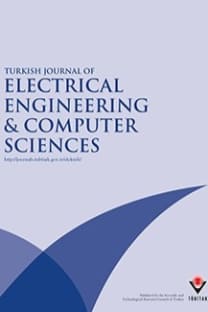Investigation of respiratory and heart rate variability in hypertensive patients
Heart rate variability, respiratory, hypertensive patients
Investigation of respiratory and heart rate variability in hypertensive patients
Heart rate variability, respiratory, hypertensive patients,
___
- Conclusion
- In future, for a better understanding of the relationship between respiration and HRV, a comparison can be made using different signal processing methods and different parameters. In particular, these operations can be implemented again on patients with respiratory disease.
- J.P. Saul, D.B. Ronald, H.C. Mind, R.J. Cohen, “Transfer function analysis of autonomic regulation II. Respiratory sinus arrhythmia”, The American Journal of Physiology - Heart and Circulatory Physiology, Vol. 25, pp. 153–161, 1989.
- L.C. Bernardi, A. Porta, L. Gabutti, P. Sleight, “Modulatory effect of respiration”, Autonomic Neuroscience Basic and Clinical, Vol. 90, pp. 47–56, 2001.
- M.V. Pitzalis, F. Mastropasqua, F. Massari, A. Passantino, “Effect of respiratory rate on the relationships between RR interval and systolic blood pressure fluctuations: a frequency-dependent phenomenon”, The American Journal of Physiology - Heart and Circulatory Physiology, Vol. 38, pp. 332–339, 1998.
- T.E. Brown, A.B. Larry, J. Koh, D.L. Eckberg, “Important respiration on human R-R interval power spectra is largely ignored”, Journal of Applied Physiology, Vol. 75, pp. 2310–2317, 1993.
- M. Poyhonen, S. Syvaoja, J. Hartikainen, E. Ruokonen, J. Takal, “The effect of carbon dioxide, respiratory rate and tidal volume on human heart rate variability”, Acta Anaesthesiologica Scandinavica, Vol. 48, pp. 93–101, 2004.
- L. Bernardi, J. Wdowczyck-Szulc, C. Valent, S. Castold, C. Passin, G. Spadacini, P. Sleight, “Effects of controlled breathing, mental activity and mental stress with or without verbalization on heart rate variability”, Journal of
- American College of Cardiology, Vol. 35, pp. 1462–1469, 2000.
- G. Strauss-Blasche, M. Moser, M. Voica, D.R. McLeod, N. Klammer, W. Marktl, “Relative timing of inspiration and expiration affects respiratory sinus arrhythmia”, Clinical and Experimental Pharmacology and Physiology, Vol.
- 27, pp. 601–606, 2000.
- J.D. Schipke, M. Pelzer, G. Arnold, “Effect of respiration rate on short-term heart rate variability”, Journal of Clinical and Basic Cardiology, Vol. 2, pp. 92–94, 1999.
- I.A. Mohamed Omar, S.A. Mohamed, “Evaluation of the analytic representation of long-record ECG and its HRV signals for congestive heart failure classification”, 28th National Radio Science Conference, pp. 1–8, 2011.
- ESC/NASPE (European Society of Cardiology/North American Society of Pacing and Electrophysiology) Task Force, “Heart rate variability: standards of measurements, physiological interpretation, and clinical use”, Circula- tion, Vol. 93, pp. 1043–1065, 1996.
- E.H. Hon, S.T. Lee “Electronic evaluations of the fetal heart rate patterns preceding fetal death, further observa- tions”, American Journal of Obstetrics and Gynecology, Vol. 87, pp. 814–826, 1965.
- M. Piepoli, P. Sleight, S. Leuzzi, F. Valle, G. Spadacini, C. Passino, J.A. Johnston, L. Benardi, “Origin of respiratory sinus arrhythmia in conscious humans an important role for the arterial carotid baroreceptor”, Circulation, Vol. 95,
- pp. 1813–1821, 1997.
- A. Melcher, “Respiratory sinus arrhythmia in man. A study in heart rate regulating mechanisms”, Acta Physiologica Scandinavica, Vol. 435, pp. 1–31, 1976.
- J.S. Wu, F.H. Lu, Y.C. Yang, T.S. Lin, J.J. Chen, C.H. Wu, Y.H. Huang, C.J. Chang, “Epidemiological study on the effect of pre-hypertension and family history of cardiac autonomic function”, Journal of American College of
- Cardiology, Vol. 51, pp. 1896–1901, 2008.
- D.R. Seals, N.O. Suwarno, M.J. Joyner, C. Iber, J.G. Copeland, J.A. Dempsey, “Respiratory modulation of muscle sympathetic nerve activity in intact and lung denervated humans”, Circulation Research, Vol. 72, pp. 440–454, 1993.
- N. Sasano, A.E. Vesely, J. Hayano, H. Sasano, R. Somogyi, D. Preiss, K. Miyasaka, H. Katsuya, S. Iscoe, J.A. Fisher, “Direct effect of PaCO2on respiratory sinus arrhythmia in conscious humans”, The American Journal of Physiology - Heart and Circulatory Physiology, Vol. 282, pp. 973–976, 2002.
- F. Yasuma, J. Hayano, “Respiratory sinus arrhythmia: why does the heartbeat synchronize with respiratory rhythm?”, Chest, Vol. 25, pp. 683–690, 2004.
- M.A. Cohen, M. Taylor, “Short-term cardiovascular oscillations in man: measuring and modelling the physiologies”, Journal of Physiology, Vol. 542, pp. 669–683, 2002.
- Q.A. Zhang, A.I. Manriquez, C.Y. Medigue Papelier, M. Sorine, “An algorithm for robust and efficient location of T-wave ends in electrocardiograms”, IEEE Transactions on Biomedical Engineering, Vol. 53, pp. 2544–2552, 2006.
- I.C. Christie, “Multivariate discrimination of emotion-specific autonomic nervous system activity”, MSc, Virginia Polytechnic Institute and State University, Blacksburg, VA, USA, 2002.
- M.H. Asyali, “Discrimination power of long-term heart rate variability measures”, Proceedings of the 25th Annual International Conference of the IEEE Engineering Medicine and Biology Society, pp. 200–203, 2003.
- J.G. Proakis, D.G. Manolakis, Digital Signal Processing Principles, Algorithms, and Applications, Upper Saddle River, NJ, USA, Prentice Hall, 1996.
- ISSN: 1300-0632
- Yayın Aralığı: Yılda 6 Sayı
- Yayıncı: TÜBİTAK
Adaptive network-based inference system models on multiband patch antenna design
Erdem DEMİRCİOĞLU, Murat Hüsnü SAZLI, Orhan ŞENGÜL, Şehabeddin Taha ˙IMECİ, Hakkı Alparslan ILGIN
Seyed Mehdi RAKHTALA, Abolfazl Ranjbar NOEI, Reza GHADERI, Elio USAI
A new systematic and flexible method for developing hierarchical decision-making models
Ulaş BELDEK, Mehmet Kemal LEBLEBİCİOĞLU
Reza Omidi GOSHEBLAGH, Karim MOHAMMADI
Asaf Behzat ŞAHİN, Hatice Gonca BULUR
Investigation of respiratory and heart rate variability in hypertensive patients
Ramazan ALDEMİR, Mahmut TOKMAKÇI
Mersenne twister-based RFID authentication protocol
Mehmet Hilal ÖZCANHAN, Gökhan DALKILIÇ
Design and implementation of IR and laser-based electronic ciphering systems
